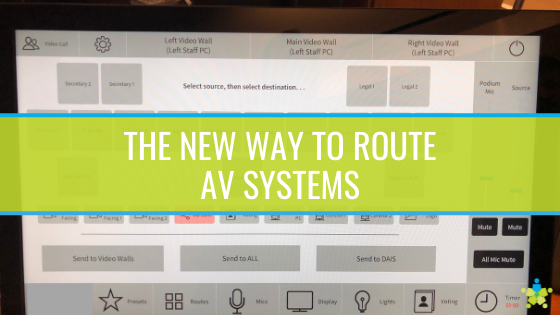[vc_row][vc_column][vc_column_text]In the last five years, the audio-visual industry has seen a boom in AV over IP as the new way to route AV systems. The trend has impacted most professional exhibitions and is now making its way to businesses and school districts across the nation. AV over IP is considered by many to be the wave of the future, but it is also an effective and valuable technology for the here and now that can be built upon for years to come.[/vc_column_text][vc_column_text]
Understanding AV over IP
AV over IP, technically known as audio-visual over Internet protocol, uses standard network equipment to transmit and switch video signals in a more modern and cost-effective way than methods of the past. In other words, this technology allows audio-visual elements (such as camera feed and microphone) to be sent via a:- Local area network (LAN). This is a network that often serves one particular building or cluster of buildings in fairly close proximity to one another.
- Wide area network (WAN). This type of network can facilitate the transmission of audio-visual signals from one building in a network to another, even if they are not right next to another.
- Internet Cloud. An Internet cloud connects local area networks and wide area networks together to provide even more comprehensive coverage for schools and businesses.
Why Ditch Traditional AV for AV over IP?
It is important to note, that even businesses and schools considering ditching traditional AV systems are already set up for AV over IP. This means that essentially most of the groundwork is already laid and bringing the audio-visual system online would not require an extremely costly investment or huge changes in protocol for the IT department. The main issue with traditional audio-visual systems is that they cannot match the modern conveniences and cost-effectiveness of the newer AV over IP systems:- Life with less cables. Traditional AV systems are notorious for the copious amounts of expensive cables needed to transmit sights and sounds. With AV over IP, an IP switcher uses less expensive and more common cables that can facilitate transmission of video and audio without as many cords.
- Pre-formatting for Internet Protocol. With the more modern set up, information transmitted via a switcher is already coded to follow Internet protocol.
- More switcher ports. Old AV systems typically feature a limited number of ports which can to a point hinder an audio-visual system’s capabilities. However, the AV over IP technology allows multiple IP switchers to be connected together to allow for much broader audio-visual capabilities.
Primary Benefits of Going with AV over IP
For many schools and businesses considering the switch to AV over IP, a primary concern becomes cost as technology upgrades often can affect the annual budget. Perhaps in contrast to most of these types of upgrades, making the switch generally tends to save money and be a more budget-friendly solution. Not only is much of the equipment already in place, any additional equipment can be purchased for a lower cost than that of a traditional AV system. With financial constraints out of the way, another concern becomes feasibility. An AV over IP system can offer more coverage for long distance transmission. Because older audio-visual systems were based primarily on physical cords and those cables can only reach so far, AV abilities were limited to a relatively small area. The new way to route AV systems allows audio and visual data to be transmitted hundreds of meters away, and the Internet cloud can go beyond even that.[/vc_column_text][vc_column_text css=".vc_custom_1626296844772{margin-bottom: 15px !important;}"]Common Examples of AV over IP Equipment
While schools and businesses using an AV over IP system should save money compared to making a more outdated and traditional system function in the long term, there may be some pieces of equipment needed to complete the transformation. Some common examples of AV over IP equipment can include:[/vc_column_text][vc_row_inner][vc_column_inner width="1/2"][vc_column_text]AMX’s SVSI Products.
As a company AMX is known for high quality switches, and models from their SVSI product family are made for AV over IP use including network video recorders, video encoders and decoders, audio transceivers, video management systems, and more.[/vc_column_text][/vc_column_inner][vc_column_inner width="1/2"][vc_column_text]Crestron’s DM NVX Series.
With some of the most advanced switches in the audio-visual industry, Crestron’s DM NVX series can be a smart choice to facilitate data transmission with 1 GB Ethernet.[/vc_column_text][/vc_column_inner][/vc_row_inner][vc_row_inner][vc_column_inner width="1/2"][vc_column_text]Extron’s Video Streaming Products.
The company Extron offers video streaming products made for AV over IP applications. Extron’s NAV Series is often the most popular of its products when it comes to AV over IP.[/vc_column_text][/vc_column_inner][vc_column_inner width="1/2"][vc_column_text]Liberty’s DigitaLinx.
This company’s 2000 Series is known for managing hundreds of displays and sources, is compatible with third-party control systems, and can support a 16x16 video wall. The 5000 Series takes these capabilities even further.[/vc_column_text][/vc_column_inner][/vc_row_inner][vc_column_text]If your company is currently utilizing an older and more traditional AV transmission operation and is looking for a new way to route your AV system, consider the more modern AV over IP system and reach out to a trusted and reputable AV integrator today.[/vc_column_text][/vc_column][/vc_row]


